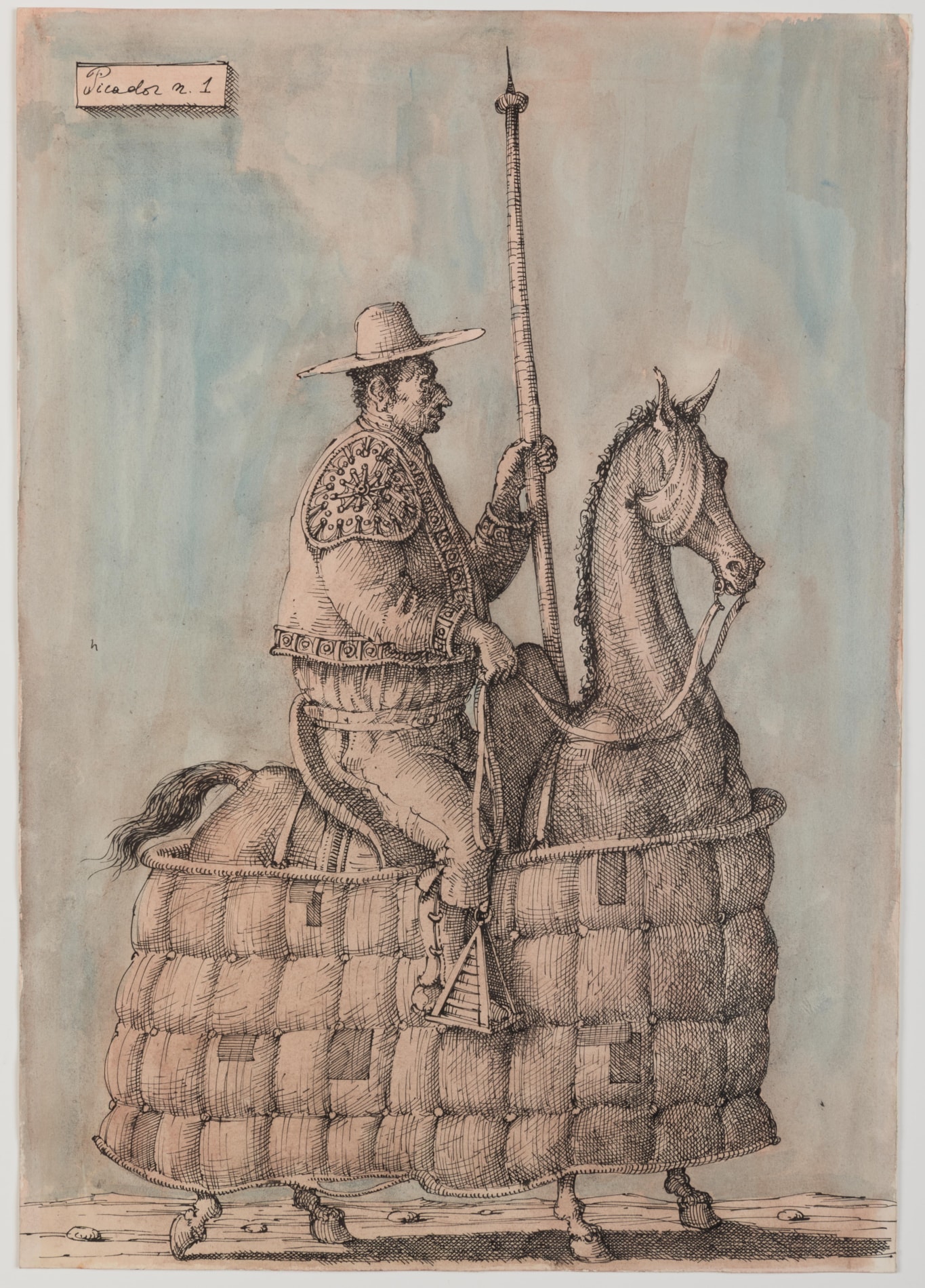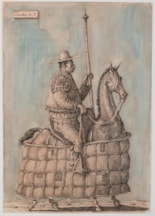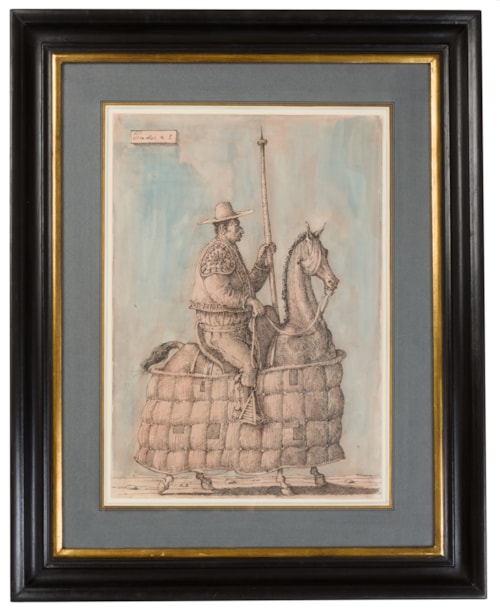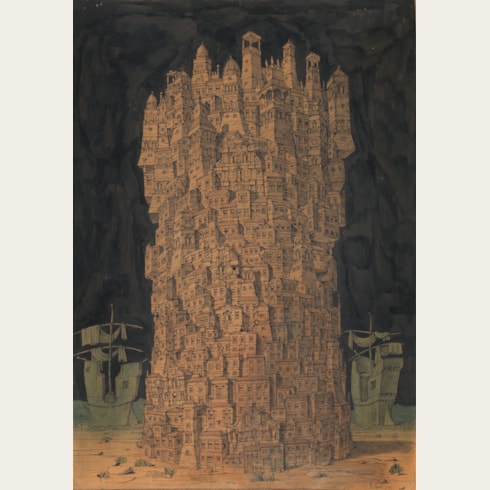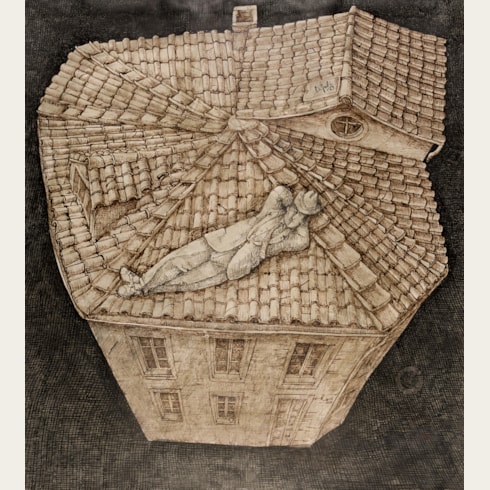Domenico GNOLI
(Rome 1933 - New York 1970)
The Village Bullfight: Picador I
Sold
Pen and black ink and watercolour. Titled Picador n.1 in a cartouche at the upper left.
Signed and dated D. Gnoli / 56 and numbered 18 on the old backing board. Illegibly inscribed in pencil on the verso.
495 x 349 mm. (19 1/2 x 13 3/4 in.)
Signed and dated D. Gnoli / 56 and numbered 18 on the old backing board. Illegibly inscribed in pencil on the verso.
495 x 349 mm. (19 1/2 x 13 3/4 in.)
The present sheet is part of a series of drawings of bullfighting scenes executed in 1956, during the first of Domenico Gnoli’s many visits to the Balearic island of Mallorca. Gnoli’s drawings were published in the American magazine Holiday the following year, under the title The Village Bullfight. Seven ink drawings from the series were exhibited at the Arthur Jeffress Gallery in London in January and February 1957. Apart from the present Picador Iand Picador II, the other five drawings were subtitled Two Picadors, Behind the Barrera, Inside and Outside, Picador Riding In and Picador Riding Out.
As a Times review of the exhibition noted, ‘Mr. Gnoli’s drawings are complex, fantasticated, and full of busy goings-on of a mildly satirical absurdity...The success of imaginative excursions of this sort depends largely on the ability of the never-never land that has been created to sustain a measure of internal plausibility by which even the most extravagant oddities become, in context, the correct and acceptable thing. The world of Mr. Gnoli’s drawings may seem a largely synthetic and artificial one, but it does establish a sense of its own private logic by its exorbitant amount of quite rational detail.’
Another anonymous review of the same exhibition expressed the opinion that ‘Dominic Gnoli is an anachronism in draughtsmanship, a modern in paint. His drawings, more meticulous than Osbert Lancaster, more fantastic than Phiz, are full of ships and towers. The myriad Lillyputian figures of bullfighters, trippers, mariners and indeterminate crowds attendant have a sophisticated whimsy which would fit a period pantomime. Gnoli’s little people are cleverly stuffed stage props.’
The first owner of the present sheet was Helen Melville Russell-Cooke, née Smith (1898-1973), whose father was Captain Edward Smith of the Titanic.
As a Times review of the exhibition noted, ‘Mr. Gnoli’s drawings are complex, fantasticated, and full of busy goings-on of a mildly satirical absurdity...The success of imaginative excursions of this sort depends largely on the ability of the never-never land that has been created to sustain a measure of internal plausibility by which even the most extravagant oddities become, in context, the correct and acceptable thing. The world of Mr. Gnoli’s drawings may seem a largely synthetic and artificial one, but it does establish a sense of its own private logic by its exorbitant amount of quite rational detail.’
Another anonymous review of the same exhibition expressed the opinion that ‘Dominic Gnoli is an anachronism in draughtsmanship, a modern in paint. His drawings, more meticulous than Osbert Lancaster, more fantastic than Phiz, are full of ships and towers. The myriad Lillyputian figures of bullfighters, trippers, mariners and indeterminate crowds attendant have a sophisticated whimsy which would fit a period pantomime. Gnoli’s little people are cleverly stuffed stage props.’
The first owner of the present sheet was Helen Melville Russell-Cooke, née Smith (1898-1973), whose father was Captain Edward Smith of the Titanic.
A precocious artist, Domenico Gnoli took private lessons in drawing and etching from the painter and printmaker Carlo Alberto Petrucci in Rome. He exhibited for the first time, aged just seventeen, at the Galleria La Cassapanca in Rome in 1950, and the following year his work was included in the exhibition Art Graphique Italien Contemporain at the Galerie Giroux in Brussels. After briefly studying theatre design at the Accademia di Belle Arti in Rome, Gnoli began working as a scenographer, producing designs for stage sets and costumes for a production of The Merchant of Venice at the Schauspielhaus in Zurich in 1953, while the following year he worked on designs for a staging of As You Like It at the Old Vic Theatre in London that opened in 1955. Despite the makings of a successful career as a scenographer, however, in 1956 Gnoli decided to give up theatrical work and to concentrate on drawing and painting. He lived between London, Paris and Rome before eventually settling in New York in 1956, where his friends included Leonard Bernstein, Henri Cartier-Bresson, Jerome Robbins and Diana Vreeland.
One-man shows of Gnoli’s drawings and prints were held in New York in 1956, London and Rome in 1957, Rome in 1958, New York in 1959, and London in 1960. He also worked as a book illustrator, writing and illustrating Orestes or the Art of Smiling, published in London in 1960, and two years later providing illustrations for the American writer Norman Juster’s Alberic the Wise and Other Journeys. He also received commissions for illustrations for magazines as diverse as Fortune, Life, Sports Illustrated, Holiday, Show, Horizon and several others, and in 1968 was awarded a gold medal by the Society of Illustrators in New York. Gnoli is perhaps best known today for his paintings executed from 1964 onwards; large canvases in which the artist almost obsessively concentrates his attention on isolated details of clothing, hair and objects.
Gnoli continued to have exhibitions of his work in Italy, France, Germany, England and America, where in 1969 his first solo exhibition of paintings was held at the Sidney Janis Gallery in New York. The year before, while that exhibition was being planned, Gnoli wrote to an American friend in New York: ‘I would hate you to think that I am just losing interest with all this, fooling myself with the idea that Janis will make a great painter out of me, and therefore I needn’t worry about drawings anymore. This would be mad, first because even if the show with him will do well it will only be a temporary success since the art scene is moving so fast that what is great today is shit tomorrow, second, I am, regardless of big money and glamour, a born illustrator, and will not renegade myself.’ Gnoli died in New York in April 1970, just over two weeks before his 37th birthday.
Works by Domenico Gnoli are today in the collections of, among others, the Stedelijk Museum in Amsterdam, the Baltimore Museum of Art, the Staatliche Museen in Berlin, the Museum of Fine Arts in Boston, the Musées Royaux des Beaux-Arts de Belgique in Brussels, the Museum Ludwig in Cologne, the Städel in Frankfurt, the Gemeentemuseum in The Hague, the Hamburger Kunsthalle in Hamburg, the Victoria and Albert Museum in London, the Museo Thyssen-Bornemisza in Madrid, the Museum of Modern Art and the Brooklyn Museum in New York, the Kunstnernes Hus in Oslo, the Philadelphia Museum of Art, the Galleria Nazionale d’Arte Moderna e Contemporanea in Rome, the Boijmans-van Beuningen Museum in Rotterdam, the Peggy Guggenheim Collection in Venice and the National Gallery of Art in Washington, D.C.
Provenance
Arthur Jeffress Gallery, London, in 1957
Purchased from them by Helen Melville Russell-Cooke
Bequeathed by her to Anthony and Marietta Coleridge, London.
Purchased from them by Helen Melville Russell-Cooke
Bequeathed by her to Anthony and Marietta Coleridge, London.
Literature
Annie de Garrou Gnoli, ‘Catalogo ragionato’, in Vittorio Sgarbi, L’opera grafica di Domenico Gnoli, Milan, 1985, p.156 (not illustrated); Carlo Barbatti and Giulia Lotti, ‘A Life in Pictures and Documents: 1933-70’, in Germano Celant et al, Domenico Gnoli, exhibition catalogue, Milan, 2021-2022, p.72.
Exhibition
London, Arthur Jeffress (Pictures) Gallery, Paintings and Drawings by Dominic Gnoli, 1957, no.18.

